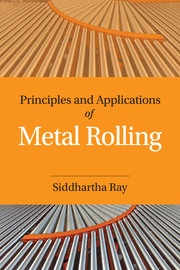2 - Mechanics of Rolling
Published online by Cambridge University Press: 05 June 2016
Summary
Characteristics of Rolling
In order to understand the rolling process, it is essential to understand some of the terms characterizing the rolling process, which are called characteristics of rolling.
These are also known as rolling process parameters.
While explaining or defining these characteristics, for the sake of simplicity, the following rolling conditions are considered:
(i) The case of simple rolling
(ii) The rolls are cylindrical with plain surface
(iii) The material or stock is rectangular in cross-section
It is to be carefully noted that while discussing the characteristics of rolling or analyzing the mechanics of rolling (i.e., determination of rolling force, etc.) often the stock material will be considered to be rectangular in cross-section meaning the rolls will be in contact with two flat surfaces of the stock, which is known as flat rolling. However, in the field of rolling, different types of rolling operation takes place for rolling products of different cross-sections, and those are achieved by passing different sections of stock through various shaped grooves made by the pair of rolls, several times.
Understanding of rolling characteristics as well as analysis of mechanics of rolling becomes easier with rectangular cross-section material. That is why the above three conditions have been considered. However, at appropriate places, grooved rolling will be taken up and discussed.
Figure 2.1 illustrates the rolling process as considered above.
Initial height and width of the stock are ‘h1’ and ‘w1’, respectively, which enter the roll with a velocity of ‘v1’. The corresponding values of the outgoing rolled stock are ‘h2’, ‘w2’, and ‘v2’. Let lengths of ingoing and outgoing stock are ‘l1’ and ‘l2’, respectively.
The various rolling characteristics or terms are explained below, primarily keeping above simplified rolling condition in view. How these characteristics may get modified under different rolling conditions, have also been mentioned.
Draught and reduction
Draught means the reduction in height in a particular pass. Absolute draught is the difference of entry thickness and exit thickness, i.e., h1-h2. Relative draught is absolute draught expressed as a percentage of initial thickness, i.e., [(h1−h2)/h1] × 100 percent. While the height is reduced during rolling, so does the cross-sectional area of the stock.
- Type
- Chapter
- Information
- Principles and Applications of Metal Rolling , pp. 30 - 103Publisher: Cambridge University PressPrint publication year: 2016



